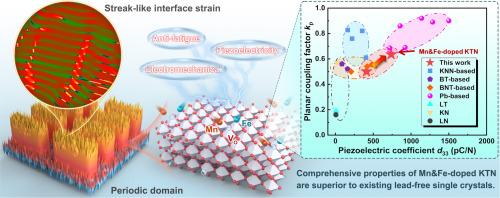Simultaneous realization of giant d33, large kp, and high Qm from periodic interface strain generated by co-doping strategy
IF 8.3
1区 材料科学
Q1 MATERIALS SCIENCE, MULTIDISCIPLINARY
引用次数: 0
Abstract
However, achieving a well-balanced performance in environment-friendly lead-free piezoelectrics remains challenging as they still fall short of their lead-based counterparts owing to the unclear promotional origins of doping modification. We propose an ion co-doping strategy that simultaneously optimizes the piezoelectricity, electromechanical performance, mechanical quality factor, and electrical anti-fatigue in KTa1−xNbxO3 (KTN) single crystals. Further, the mechanism underlying the enhancement of these properties is elucidated. Microscopic and mesoscopic evidence demonstrate a more uniform order parameter induced by the co-doping defect structures, thereby yielding hierarchical domains and ordered lattice planes. At the atomic scale, the periodic interface strain induced by Mn and Fe co-doping orders the atomic arrangements, thereby stabilizing the polarization and domain states. Thus, the advantageous functions of both Mn and Fe ions are maintained. The superior overall properties of the co-doped KTN reach the level of lead-based single crystals. This work provides valuable insights into achieving piezoelectrics with excellent comprehensive performances using a co-doping strategy, while also advancing the understanding of how defect structures improve piezoelectric properties.

求助全文
约1分钟内获得全文
求助全文
来源期刊

Acta Materialia
工程技术-材料科学:综合
CiteScore
16.10
自引率
8.50%
发文量
801
审稿时长
53 days
期刊介绍:
Acta Materialia serves as a platform for publishing full-length, original papers and commissioned overviews that contribute to a profound understanding of the correlation between the processing, structure, and properties of inorganic materials. The journal seeks papers with high impact potential or those that significantly propel the field forward. The scope includes the atomic and molecular arrangements, chemical and electronic structures, and microstructure of materials, focusing on their mechanical or functional behavior across all length scales, including nanostructures.
 求助内容:
求助内容: 应助结果提醒方式:
应助结果提醒方式:


